Experimental Modelling of an Isolated WECfarm Real-Time Controllable Heaving Point Absorber Wave Energy Converter
Abstract
1. Introduction
2. Experimental Setup
2.1. WECfarm WEC and Instrumentation
2.2. Wave Basin Setup
3. Results
3.1. Test Matrix
3.2. Friction Model
3.2.1. Friction Characterization Tests
3.3. System Identification
3.3.1. Linear Decomposed Wave–WEC Interaction Model
3.3.2. Impedance Formulation and Radiation Tests
3.3.3. Excitation Tests
3.3.4. Free Decay Tests
3.4. Power Absorption
3.4.1. Impedance Matching
3.4.2. Causal Impedance Matching P and PI Controller
3.4.3. Resistive Control
3.4.4. Reactive Control
3.4.5. Power Absorption Comparison between the Resistive and Reactive Controller
4. Discussion and Conclusions
Author Contributions
Funding
Institutional Review Board Statement
Informed Consent Statement
Data Availability Statement
Acknowledgments
Conflicts of Interest
Abbreviations
| AAU | Aalborg University |
| ABS | Acrylonitril-Butadieen-Styreen |
| AT | Amplifier Telegramm |
| BEM | Boundary Element Method |
| CFD | Computational fluid dynamics |
| CNWT | CFD-based numerical wave tank |
| COB | Coastal and Ocean Basin |
| DAQ | Data Acquisition System |
| DOFs | Degrees of Freedom |
| EtherCAT | Ethernet for Control Automation Technology |
| FFT | Fast Fourier Transform |
| FRF | Frequency response function |
| FSO | Full Scale Output |
| I/O | Input and Output |
| JONSWAP | Joint North Sea Wave Project |
| MDT | Master Data Telegramm |
| MWL | Mean Water Level |
| MISO | Multiple input single output |
| OCT | One Cable Technology |
| P | Proportional |
| PI | Proportional Integral |
| PID | Proportional Integral Derivative |
| PMMA | Polymethylmethacrylate |
| PMSM | Permanent Magnet Synchronous Motor |
| PTO | Power Take-Off |
| RAO | Response Amplitude Operator |
| SID | System Identification |
| SISO | Single input single output |
| SWL | Still Water Level |
| WEC | Wave Energy Converter |
| WG | Wave Gauge |
References
- Falnes, J.; Lillebekken, P.M. Budal’s latching-controlled-buoy type wave-power plant. In Proceedings of the European Wave Energy Conference, Cork, Ireland, 17–20 September 2003; pp. 233–244. [Google Scholar]
- Göteman, M.; Giassi, M.; Engström, J.; Isberg, J. Advances and Challenges in Wave Energy Park Optimization—A Review. Front. Energy Res. 2020, 8, 26. [Google Scholar] [CrossRef]
- Windt, C.; Davidson, J.; Ringwood, J. High-fidelity numerical modelling of ocean wave energy systems: A review of computational fluid dynamics-based numerical wave tanks. Renew. Sustain. Energy Rev. 2018, 93, 610–630. [Google Scholar] [CrossRef]
- Vervaet, T.; Stratigaki, V.; De Backer, B.; Stockman, K.; Vantorre, M.; Troch, P. Experimental modelling of point absorber wave energy converter arrays: A comprehensive review, identification of research gaps and design of the WECfarm setup. J. Mar. Sci. Eng. 2022, 10, 1062. [Google Scholar] [CrossRef]
- Nader, J.R.; Fleming, A.; Macfarlane, G.; Penesis, I.; Manasseh, R. Novel experimental modelling of the hydrodynamic interactions of arrays of wave energy converters. Int. J. Mar. Energy 2017, 20, 109–124. [Google Scholar] [CrossRef]
- Stallard, T.; Stansby, P.K.; Williamson, A.J. An experimental study of closely spaced point absorber arrays. In Proceedings of the International Offshore and Polar Engineering Conference, Vancouver, BC, Canada, 6–11 July 2008. [Google Scholar]
- Folley, M.; Whittaker, T. Preliminary Cross-Validation of Wave Energy Converter Array Interactions. In Proceedings of the International Conference on Offshore Mechanics and Arctic Engineering—OMAE, Nantes, France, 8–13 June 2013; Volume 10837. [Google Scholar]
- Stratigaki, V.; Troch, P.; Stallard, T.; Forehand, D.; Kofoed, J.P.; Folley, M.; Benoit, M.; Babarit, A.; Kirkegaard, J. Wave basin experiments with large wave energy converter arrays to study interactions between the converters and effects on other users in the sea and the coastal area. Energies 2014, 7, 701–734. [Google Scholar] [CrossRef]
- Troch, P.; Stratigaki, V.; Devriese, P.; Kortenhaus, A.; De Maeyer, J.; Monballiu, J.; Toorman, E.; Rawoens, P.; Vanneste, D.; Suzuki, T.; et al. Design features of the upcoming coastal and ocean basin in Ostend, Belgium. In Proceedings of the Coastal Structures Conference, Hannover, Germany, 30 September–2 October 2019; Goseberg, N., Schlurmann, T., Eds.; pp. 1191–1199. [Google Scholar]
- Beatty, S.; Ferri, F.; Bocking, B.; Kofoed, J.P.; Buckham, B. Power Take-Off Simulation for Scale Model Testing of Wave Energy Converters. Energies 2017, 10, 973. [Google Scholar] [CrossRef]
- Bacelli, G.; Ringwood, J. Constrained control of arrays of wave energy devices. Int. J. Mar. Energy 2013, 3–4, 53–69. [Google Scholar] [CrossRef]
- Coe, R.G.; Bacelli, G.; Forbush, D. A practical approach to wave energy modeling and control. Renew. Sustain. Energy Rev. 2021, 142, 110791. [Google Scholar] [CrossRef]
- Bacelli, G.; Coe, R.G.; Patterson, D.; Wilson, D. System Identification of a Heaving Point Absorber: Design of Experiment and Device Modeling. Energies 2017, 10, 472. [Google Scholar] [CrossRef]
- OAV Air Bearings. OAV Air Bearing Product Book & Design Guide: Where Aerospace Techonology Meets Air Bearing Systems. 2021. Available online: https://www.oavco.com/brochures (accessed on 7 July 2021).
- Beckhoff Automation. Beckhoff New Automation Technology, Operation Instructions, AM8000 and AM8500: Synchronous Servomotors, Version 4.9. 2022. Available online: https://download.beckhoff.com/download/document/motion/am8000_am8500_ba_en.pdf (accessed on 5 October 2022).
- Beckhoff Automation. AM8542-wEyz|Servomotor with Increased Moment of Inertia 4.10 Nm (M0), F4 (87 mm). 2022. Available online: https://www.beckhoff.com/nl-be/products/motion/rotary-servomotors/am8500-servomotors-with-increased-rotor-moment-of-inertia/am8542-weyz.html (accessed on 2 June 2022).
- Analog Devices. ADXL335: Small, Low Power, 3-Axis ±3 g Accelerometer. 2022. Available online: https://www.analog.com/media/en/technical-documentation/data-sheets/ADXL335.pdf (accessed on 5 October 2022).
- Vishay Precision Group. Model 614, Tedea-Huntleigh: Tension Compression Load Cell. 2022. Available online: http://www.vishaypg.com/docs/12040/614.pdf (accessed on 5 October 2022).
- Micro-Epsilon. Operating Instructions optoNCDT 1420. 2022. Available online: https://www.micro-epsilon.com/download/manuals/man–optoNCDT-1420–en.pdf (accessed on 5 October 2022).
- Lamont-Kane, P.; Folley, M.; Whittaker, T. Investigating Uncertainties in Physical Testing of Wave Energy Converter Arrays. In Proceedings of the 10th European Wave and Tidal Energy Conference Series—EWTEC, Aalborg, Denmark, 2–5 September 2013. [Google Scholar]
- Aalborg University. Ocean and Coastal Engineering Laboratory. 2022. Available online: https://www.en.build.aau.dk/laboratories/ocean-and-coastal-engineering/ (accessed on 25 June 2021).
- Aalborg University. AwaSys. 2022. Available online: https://www.hydrosoft.civil.aau.dk/awasys/ (accessed on 2 August 2022).
- OAV Air Bearings. Friction Coefficient 40 mm OAV Air Bushings; e-mail communication, from 24 June 2021; OAV Air Bearings: Princeton, NJ, USA, 2021. [Google Scholar]
- Wittenstein Alpha. Gearbox ’NPR 025S-MF1-4 -2E1-1S’ Break-Away Torque; e-mail communication, from 16 December 2021; Wittenstein Alpha: Igersheim, Germany, 2021. [Google Scholar]
- Armstrong-Helouvry, B.; Dupont, P.; Canudas de Wit, C. A Survey of Models, Analysis Tools and Compensation Methods for the Control of Machines with Friction. Automatica 1994, 30, 1083–1138. [Google Scholar] [CrossRef]
- Wittenstein Alpha. Alpha Basic Line & Alpha Value Line Product Catalog. 2022. Available online: https://alpha.wittenstein.de/en-en/alpha-value-line/ (accessed on 8 September 2022).
- Verbrugghe, T. openWEC: Open Source Wave Energy Converter (WEC) Simulation Tool, Ghent University. 2018. Available online: https://users.ugent.be/~tverbrug/ (accessed on 2 June 2022).
- Yang, P.; Zhang, Z.; Zhao, J.; Zhou, D. Improved PID Friction Feed-forward Compensation Control Based on Segment Friction Model. Open Autom. Control. Syst. J. 2014, 6, 1620–1628. [Google Scholar] [CrossRef][Green Version]
- Ringwood, J.; Davidson, J.; Giorgi, S. Identifying Models Using Recorded Data. In Numerical Modelling of Wave Energy Converters; Academic Press: Cambridge, MA, USA, 2016; pp. 123–147. [Google Scholar]
- Falcão, A.F.d.O. Wave energy utilization: A review of the technologies. Renew. Sustain. Energy Rev. 2009, 14, 899–918. [Google Scholar] [CrossRef]
- Stratigaki, V. Experimental Study and Numerical Modelling of Intra-Array Interactions and Extra-Array Effects of Wave Energy Converter Arrays. Ph.D. Thesis, Ghent University, Ghent, Belgium, 2014. [Google Scholar]
- De Backer, G.; Vantorre, M.; Frigaard, P.; Beels, C.; De Rouck, J. Bottom slamming on heaving point absorber wave energy devices. J. Mar. Sci. Technol. 2010, 15, 119–130. [Google Scholar] [CrossRef][Green Version]
- Morison, J.R.; O’Brien, M.P.; Johnson, J.W.; Schaaf, S. The force exerted by surface waves on piles. Pet. Trans. AIME 1950, 2, 149–154. [Google Scholar] [CrossRef]
- Penalba, M.; Giorgi, G.; Ringwood, J. A Review of Non-Linear Approaches for Wave Energy Converter Modelling. In Proceedings of the 11th European Wave and Tidal Energy Conference, Nantes, France, 6–11 September 2015. [Google Scholar]
- Giorgi, G.; Ringwood, J.V. Nonlinear Froude-Krylov and viscous drag representations for wave energy converters in the computation/fidelity continuum. Ocean Eng. 2017, 141, 164–175. [Google Scholar] [CrossRef]
- Quartier, N.; Ropero-Giralda, P.; MDomínguez, J.; Stratigaki, V.; Troch, P. Influence of the drag force on the average absorbed power of heaving wave energy converters using smoothed particle hydrodynamics. Water 2021, 13, 384. [Google Scholar] [CrossRef]
- Antony, M.S.; Praveen Raj, R.S. Four Quadrant Operation of Vector Control of PMSM with Dynamic Braking. In Proceedings of the International Conference on Control, Communication & Computing India (ICCC), Trivandrum, India, 19–21 November 2015. [Google Scholar]
- Faedo, N.; Carapellese, F.; Pasta, E.; Mattiazzo, G. On the principle of impedance-matching for underactuated wave energy harvesting systems. Appl. Ocean. Res. 2022, 118, 102958. [Google Scholar] [CrossRef]
- Gu, Y.; Ding, B.; Sergiienko, N.Y.; Cazzolato, B.S. Power maximising control of a heaving point absorber wave energy converter. IET Renew. Power Gener. 2021, 15, 3296–3308. [Google Scholar] [CrossRef]
- Coe, R.G.; Bacelli, G.; Wilson, D.G.; Abdelkhalik, O.; Korde, U.A.; Robinett, R.D. A comparison of control strategies for wave energy converterss. Int. J. Mar. Energy 2017, 20, 45–63. [Google Scholar] [CrossRef]
- Falcão, A.F.d.O.; Henriques, J.C.C. Effect of non-ideal power take-off efficiency on performance of single- and two-body reactively controlled wave energy converters. J. Ocean Eng. Mar. Energy 2015, 1, 273–286. [Google Scholar] [CrossRef]
- Strager, T.; Martin dit Neuville, A.; Fernandez Lopez, P.; Giorgio, G.; Muresan, T.; Andersen, P.; Nielsen, K.M.; Pedersen, T.S.; Vidal Sanchez, E. Optimising Reactive Control In Non-Ideal Efficiency Wave Eenergy Converters. In Proceedings of the ASME 2014 33rd International Conference on Ocean, Offshore and Arctic Engineering, San Francisco, CA, USA, 8–13 June 2014. [Google Scholar]
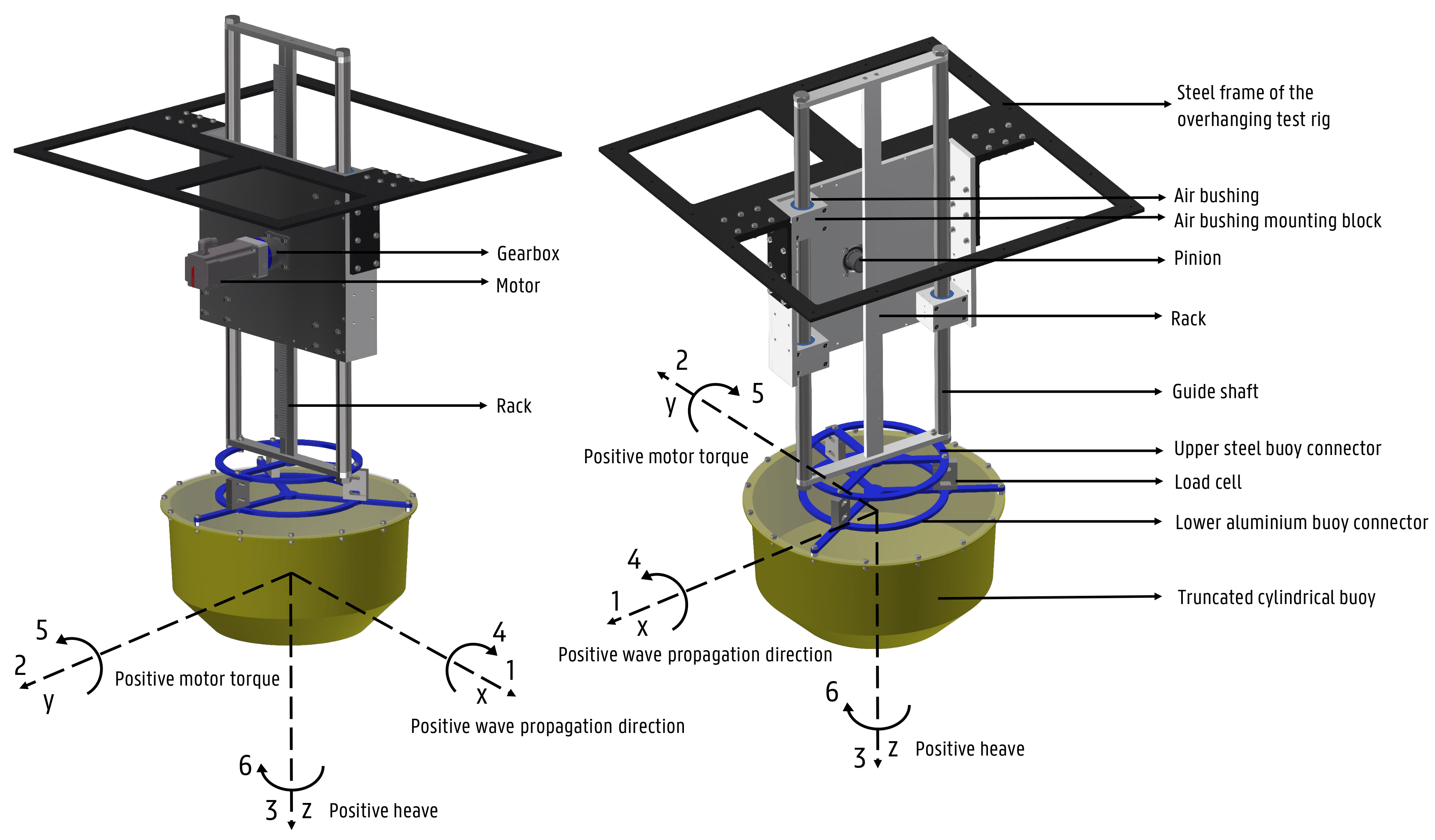
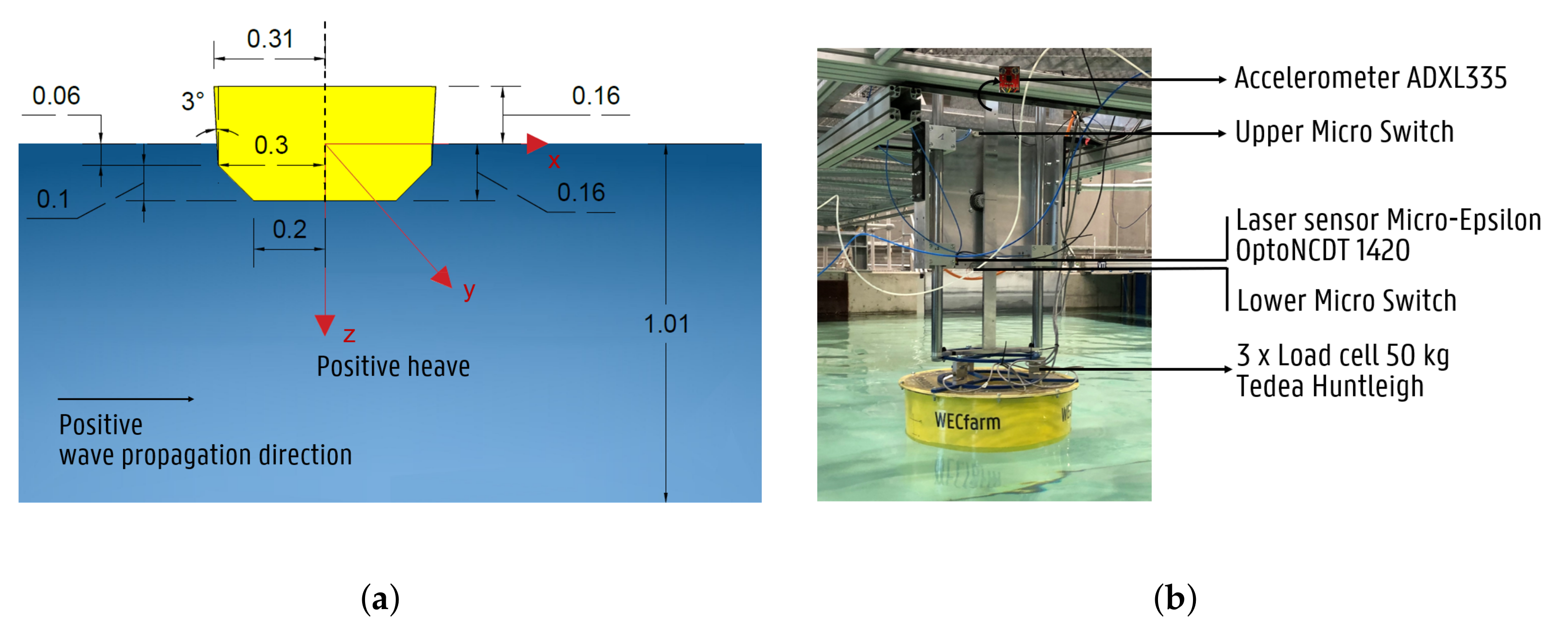

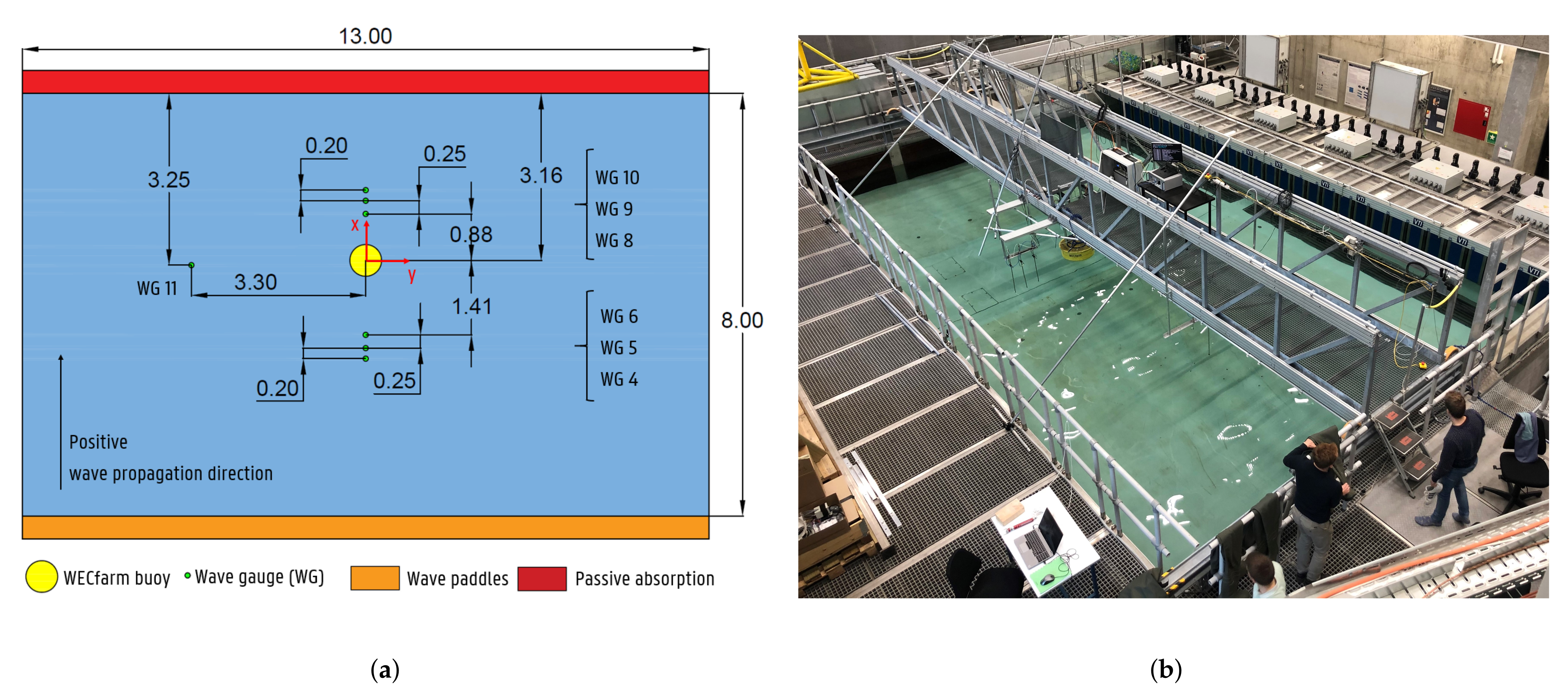

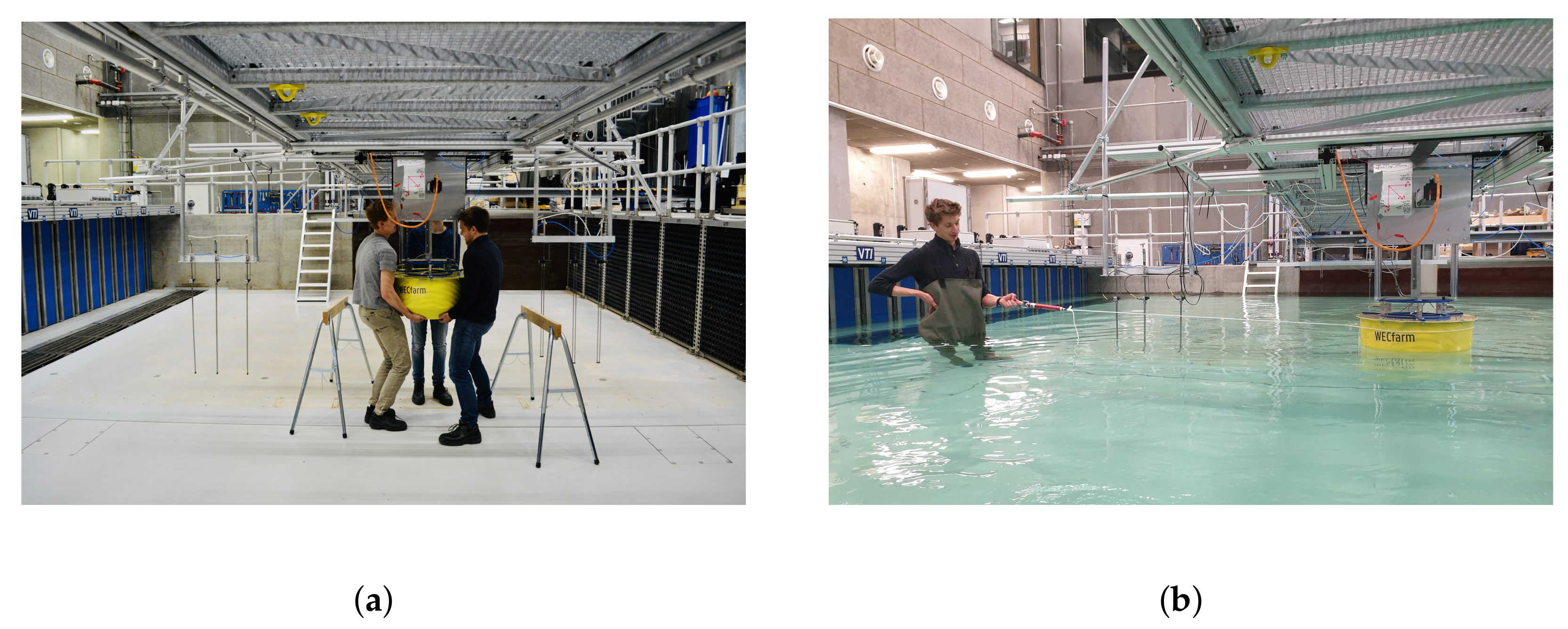
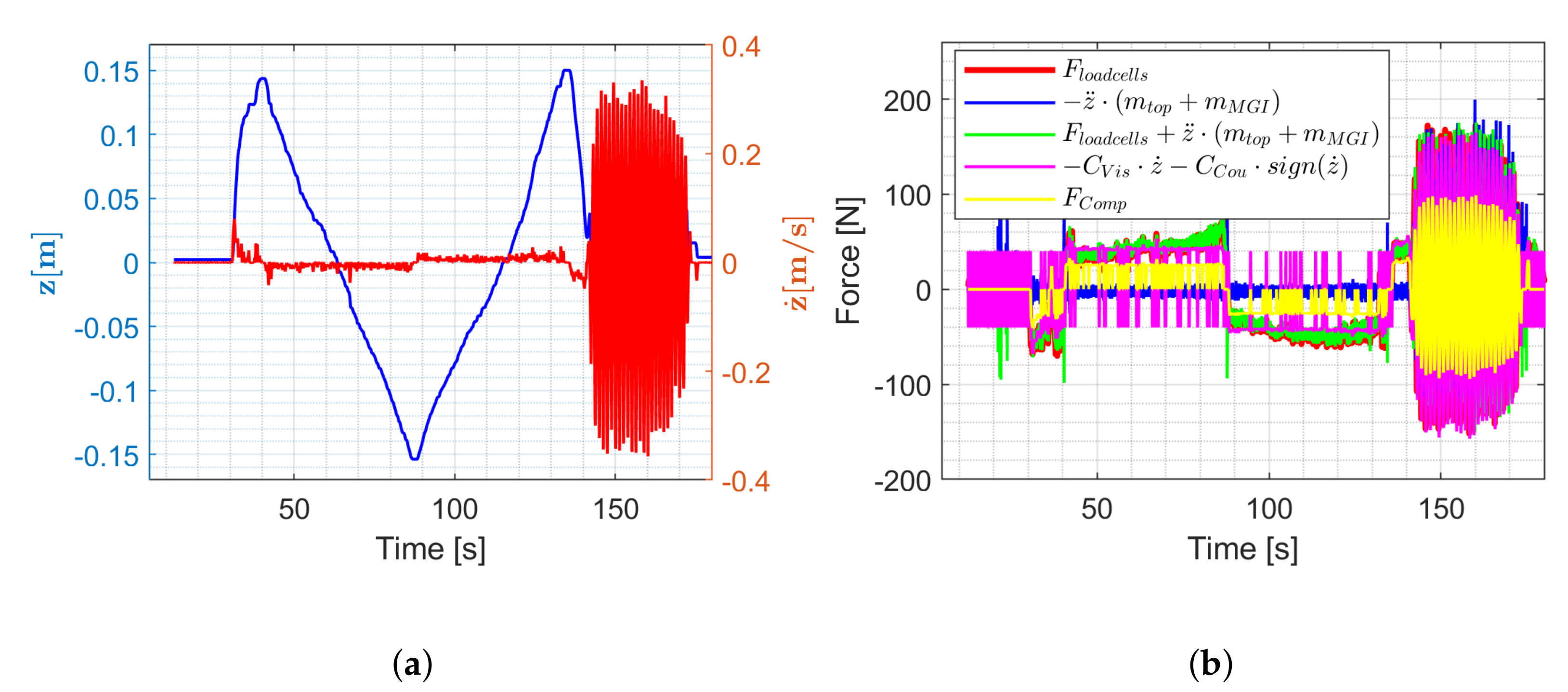
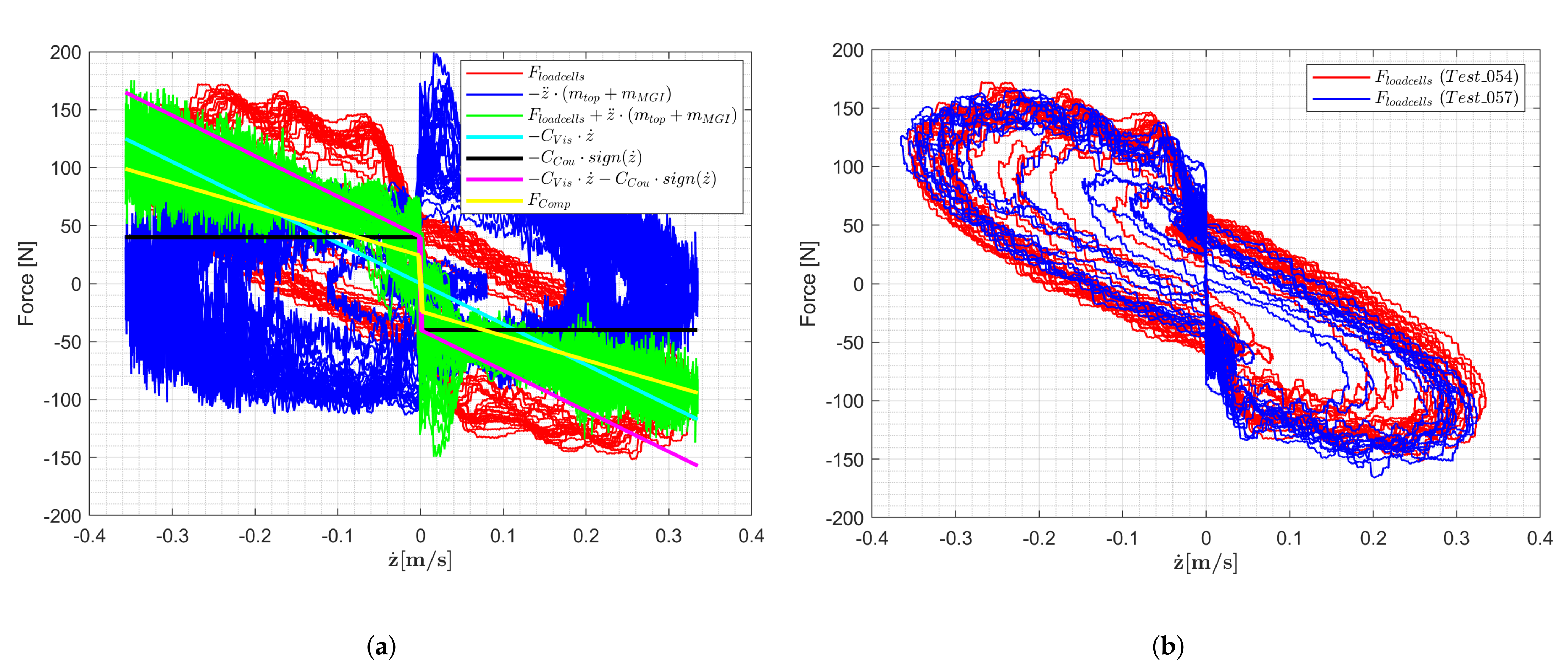
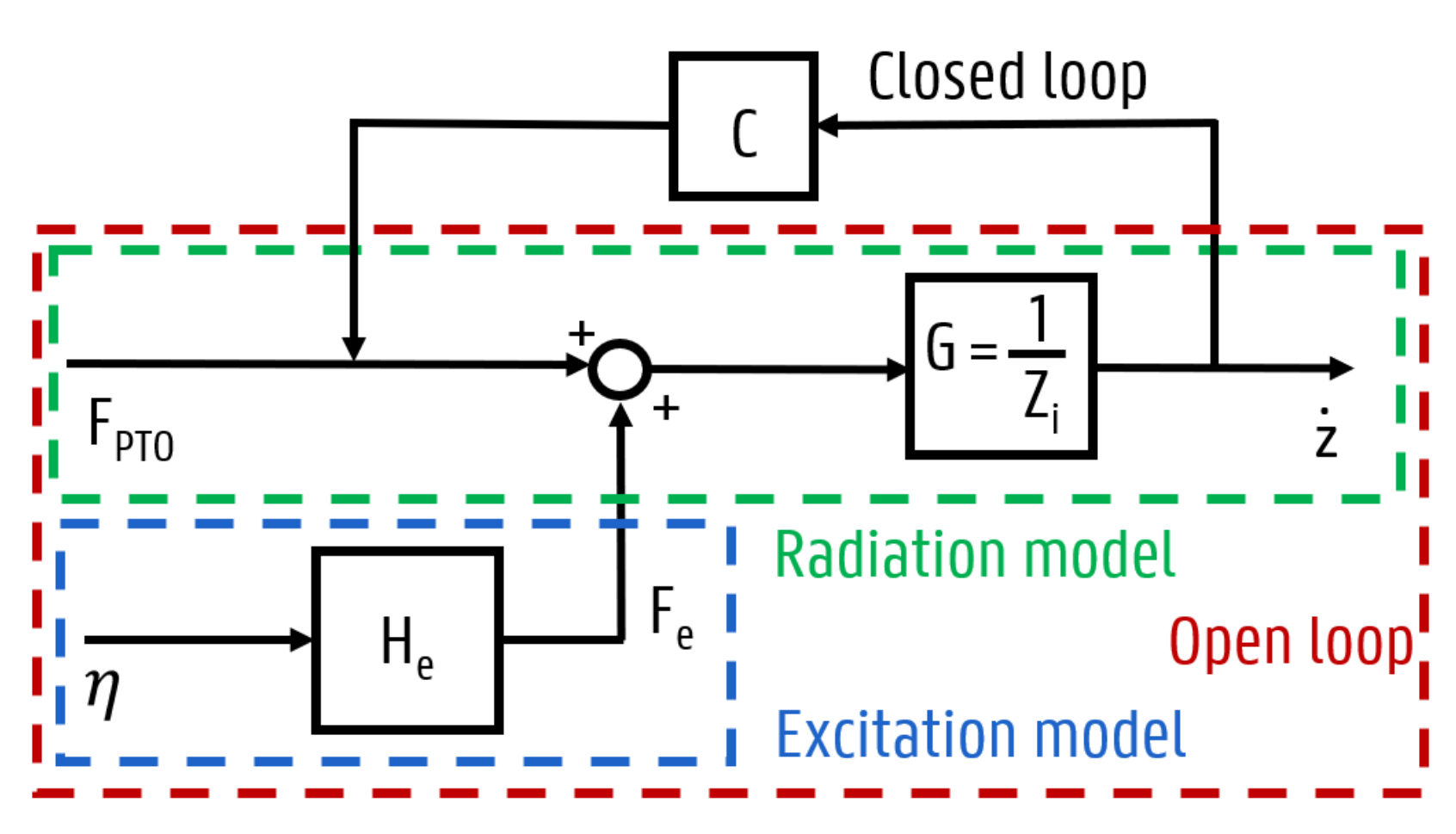
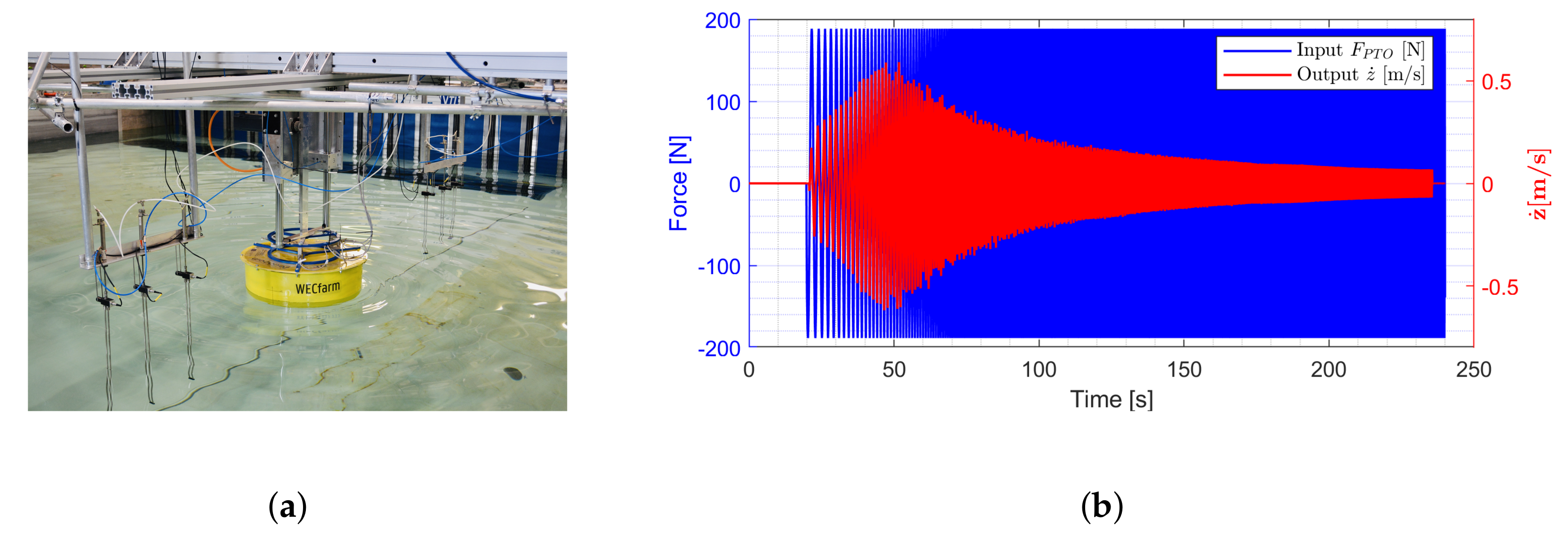


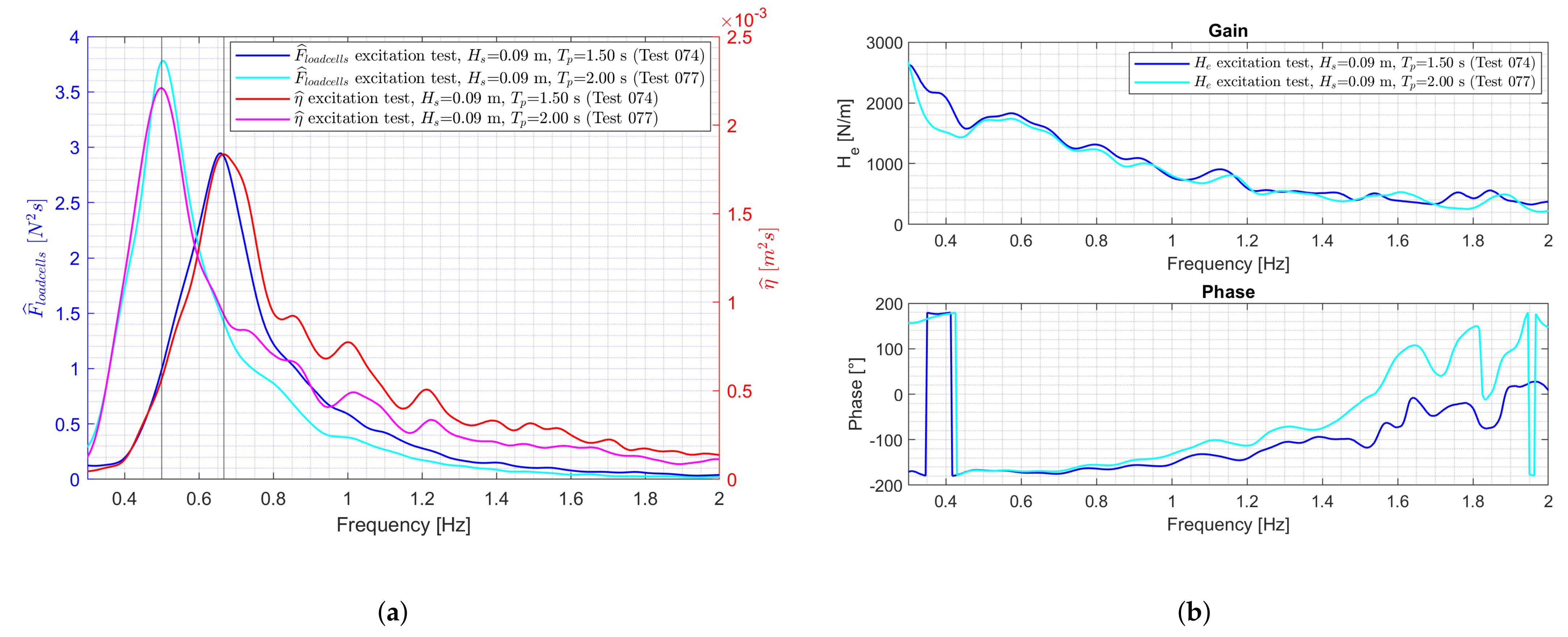
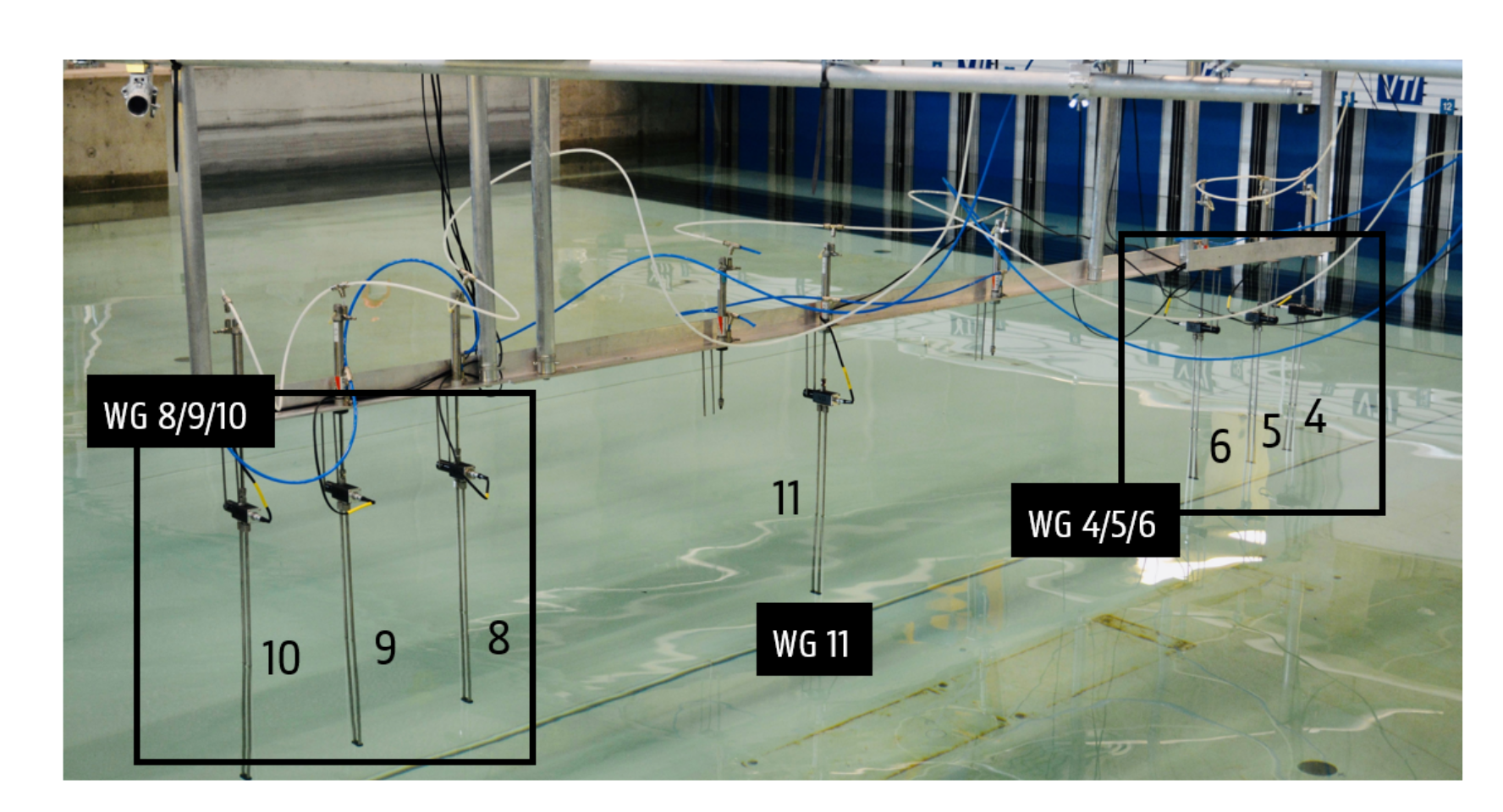
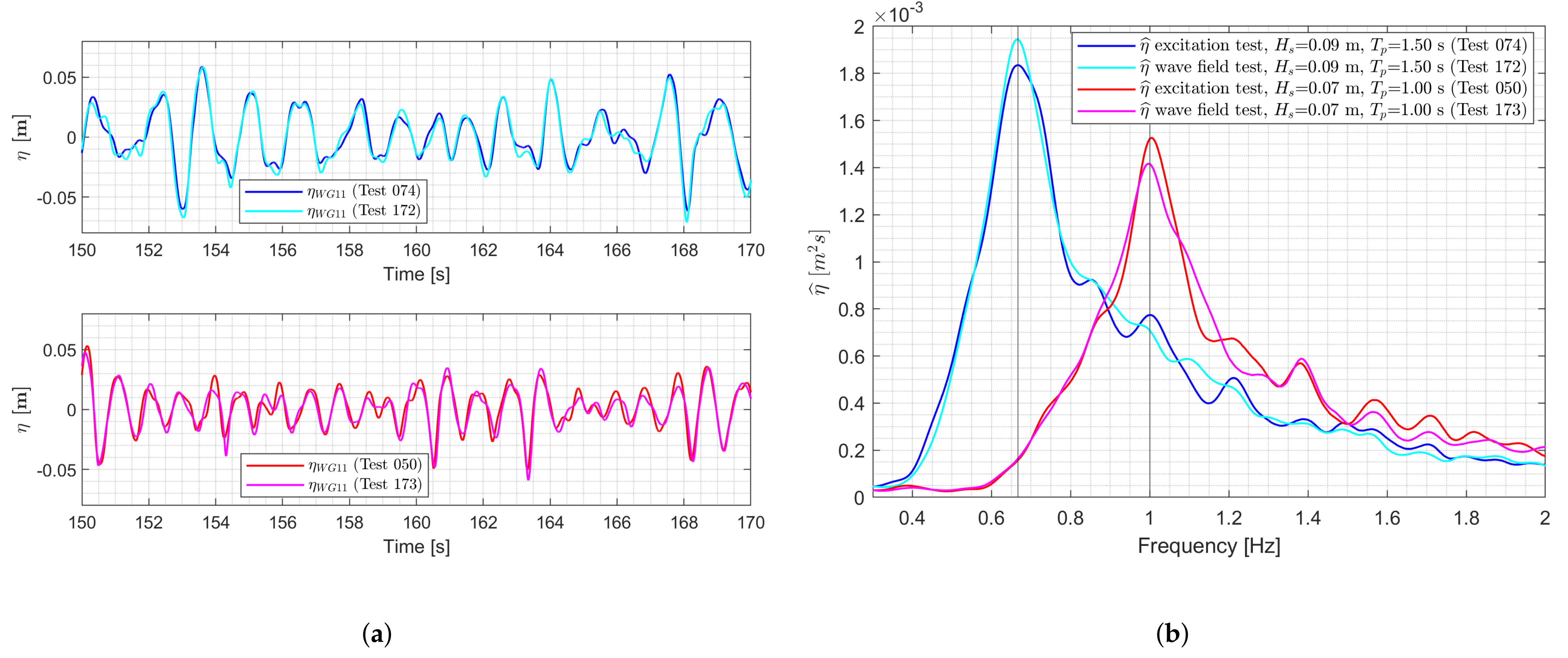


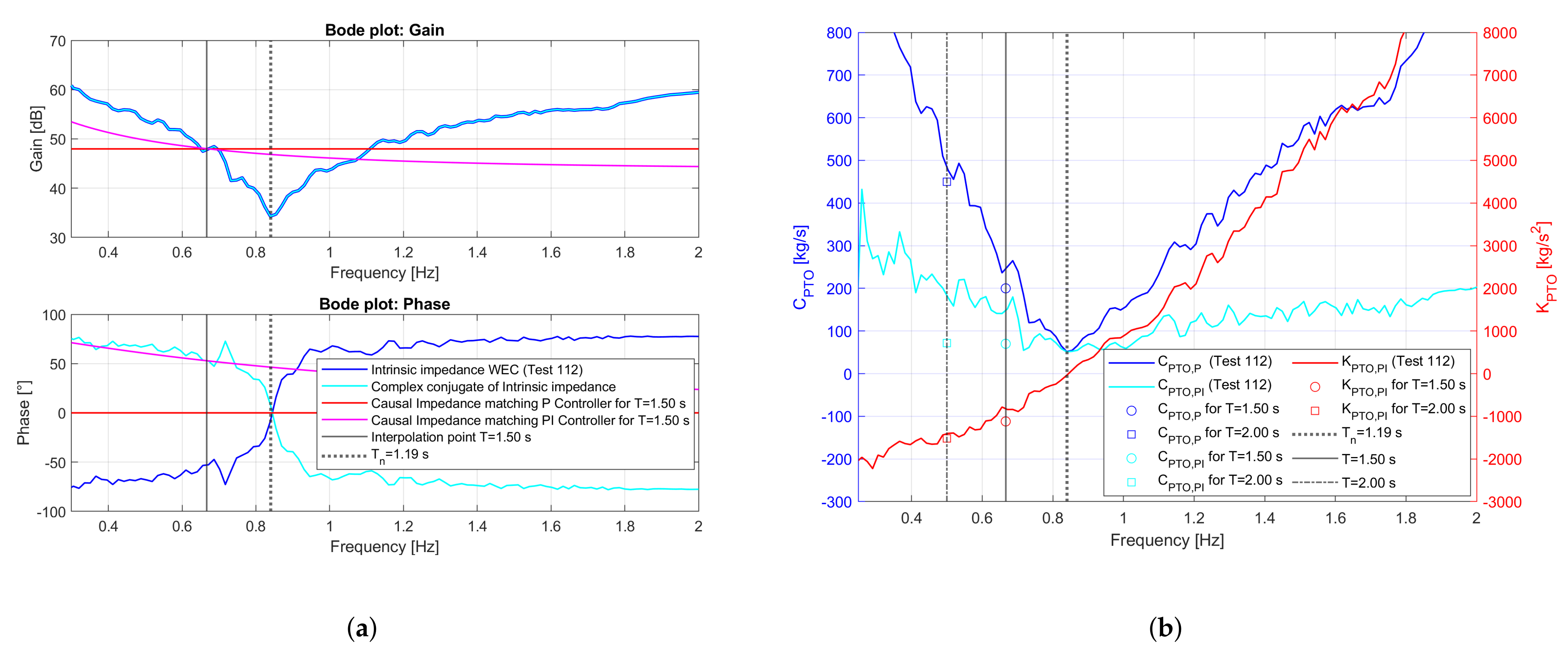
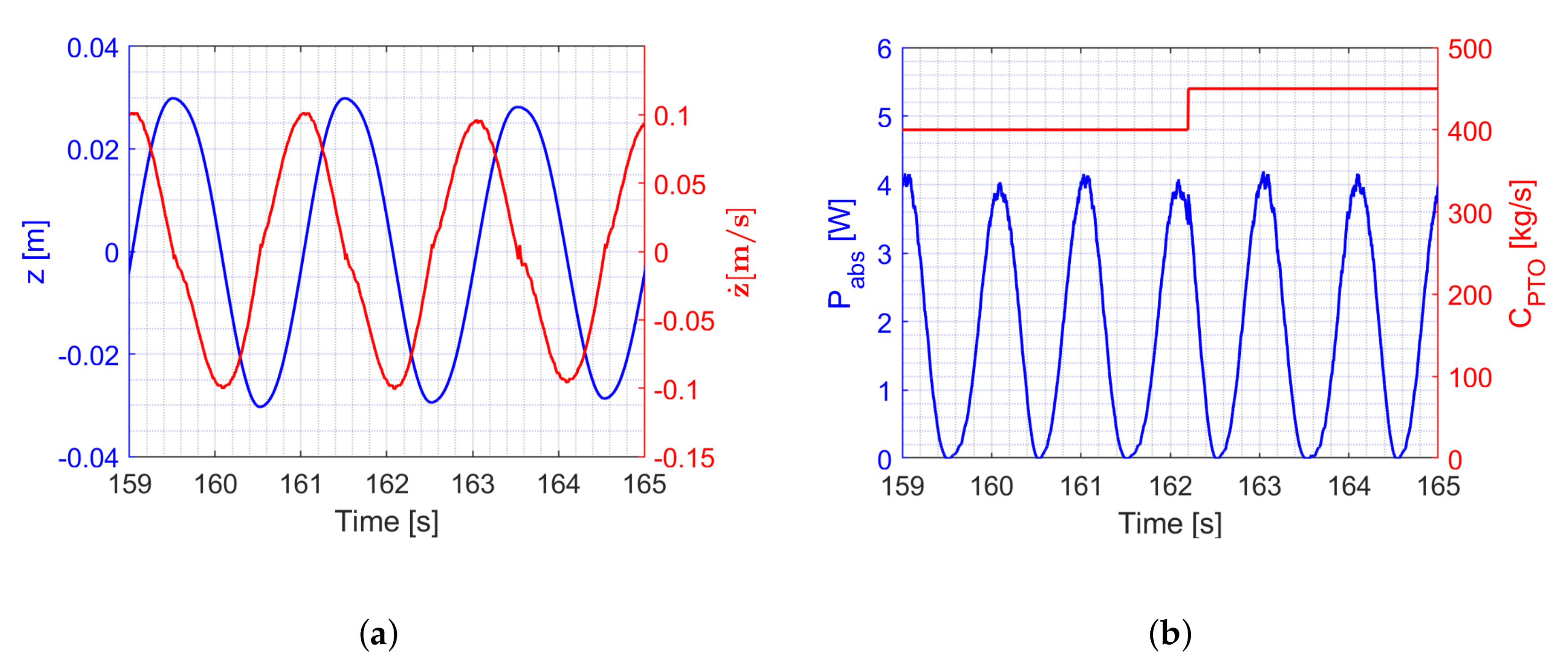
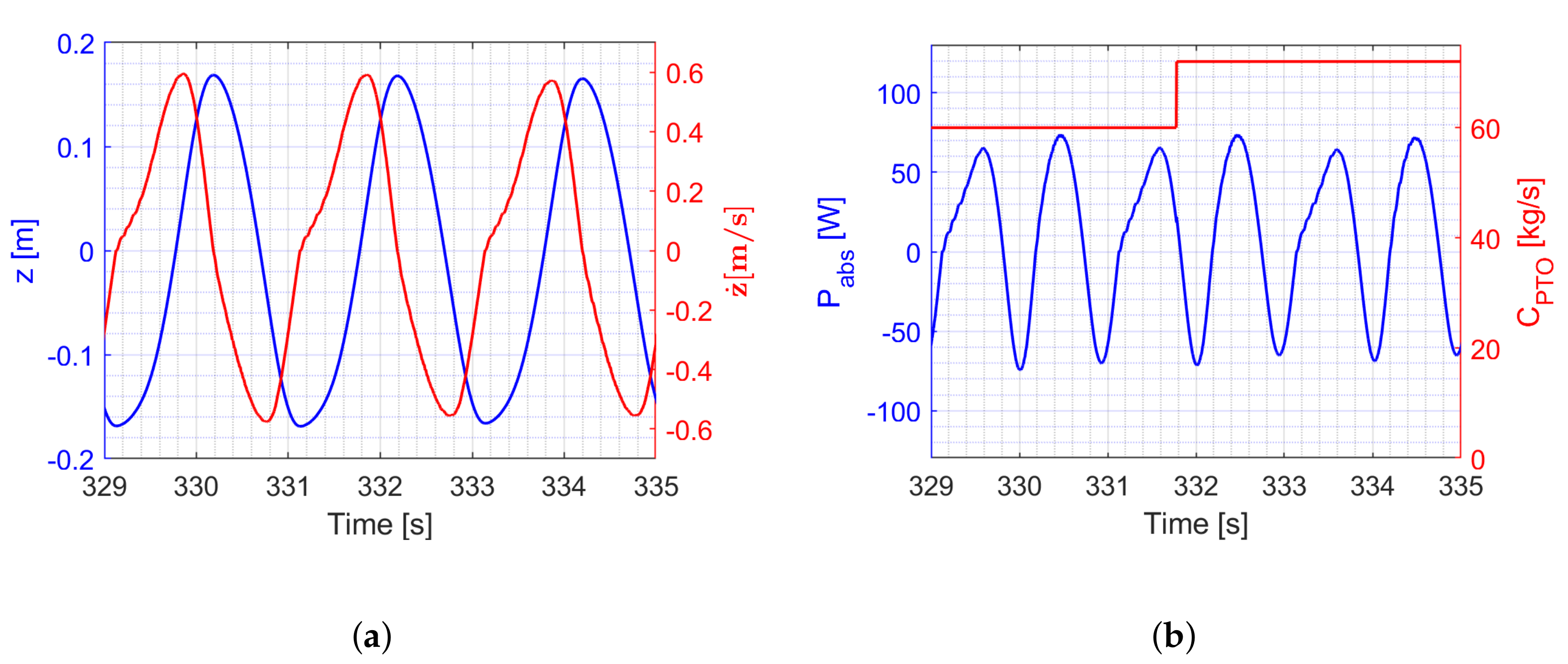
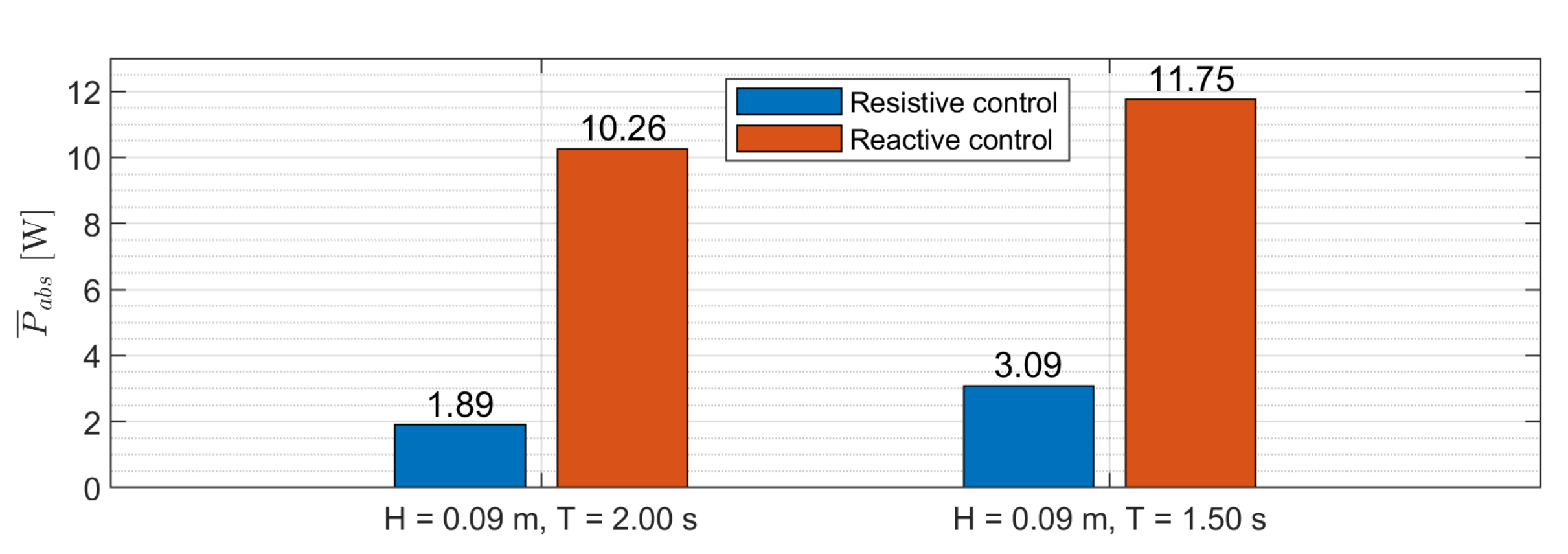
| Category | Test Type |
|---|---|
| Friction model | Friction characterization tests |
| System Identification | Radiation tests |
| Excitation tests | |
| Free decay tests | |
| Power absorption | Resistive control tests |
| Reactive control tests |
| [Ns/m] | [N] | [-] | [m/s] |
|---|---|---|---|
| 350 | 40 | 0.60 | 0.0012 |
| Test_ID | Filled Basin | Loading Force [kg] | Loading Direction | Air Pressure [bar] |
|---|---|---|---|---|
| Test_007 | no | - | - | 5.0 |
| Test_008 | no | - | - | 5.0 |
| Test_009 | no | - | - | 0 |
| Test_024 | yes | - | - | 5.0 |
| Test_025 | yes | 10 | −x | 5.0 |
| Test_026 | yes | 15 | −x | 5.5 |
| Test_054 | yes | - | - | 5.5 |
| Test_055 | yes | 10 | −x | 5.5 |
| Test_056 | yes | 15 | −x | 5.5 |
| Test_057 | yes | 20 | −x | 5.5 |
| Test_058 | yes | 15 | y | 5.5 |
| Test_ID | PTO Input | Target Time [s] | Frequency Range [Hz] | PTO Gain | [-] | [m] |
|---|---|---|---|---|---|---|
| Test_018 | Chirp-up | 220 | 0.0–4.0 | 1.0 | 0.0 | 0.115 |
| Test_021 | Chirp-down | 220 | 4.0–0.0 | 1.0 | 0.0 | 0.122 |
| Test_053 | Chirp-up | 220 | 0.0–4.0 | 1.0 | 0.0 | 0.123 |
| Test_059 | Chirp-up | 220 | 0.0–4.0 | 1.0 | 0.0 | 0.116 |
| Test_066 | Chirp-up | 220 | 0.0–4.0 | 0.5 | 0.0 | 0.041 |
| Test_109 | Chirp-up | 220 | 0.0–4.0 | 1.0 | 0.0 | 0.127 |
| Test_112 | Chirp-up | 220 | 0.0–4.0 | 0.3 | 0.6 | 0.152 |
| Test_113 | Chirp-down | 220 | 4.0–0.0 | 0.3 | 0.6 | 0.162 |
| Test_163 | Chirp-up | 220 | 0.0–4.0 | 1.0 | 0.0 | 0.128 |
| Test_ID | Wave Input | [m] | [s] | Test_ID | Wave Input | [m] | [s] |
|---|---|---|---|---|---|---|---|
| Test_048 | JONSWAP | 0.05 | 1.0 | Test_076 | JONSWAP | 0.07 | 2.0 |
| Test_049 | JONSWAP | 0.05 | 1.0 | Test_077 | JONSWAP | 0.09 | 2.0 |
| Test_050 | JONSWAP | 0.07 | 1.0 | Test_078 | JONSWAP | 0.11 | 2.0 |
| Test_071 | JONSWAP | 0.09 | 1.0 | Test_133 | Regular | 0.09 | 2.0 |
| Test_072 | JONSWAP | 0.05 | 1.5 | Test_144 | JONSWAP | 0.07 | 2.0 |
| Test_073 | JONSWAP | 0.07 | 1.5 | Test_145 | JONSWAP | 0.13 | 2.0 |
| Test_074 | JONSWAP | 0.09 | 1.5 | Test_167 | JONSWAP | 0.20 | 1.5 |
| Test_075 | JONSWAP | 0.05 | 2.0 | Test_168 | JONSWAP | 0.30 | 2.0 |
| Test_ID | Wave Input | [m] | [s] |
|---|---|---|---|
| Test_172 | JONSWAP | 0.09 | 1.5 |
| Test_173 | JONSWAP | 0.07 | 1.0 |
| Test_174 | JONSWAP | 0.05 | 2.0 |
| Test_175 | Regular | 0.09 | 2.0 |
| Test_ID | [m] | [-] | n | [-] | [s] |
|---|---|---|---|---|---|
| Test_089 | −0.089 | 0.6 | 2 | 0.13 | 1.19 |
| Test_129 | 0.078 | 0.6 | 3 | 0.12 | 1.19 |
| Test_161 | −0.202 | 0.6 | n.a. | n.a. | n.a. |
| Test_162 | −0.222 | 0.0 | n.a. | n.a. | n.a. |
| Test_170 | 0.082; 0.140; 0.113; | n.a. | 4 | 0.14 | 1.00 |
| (no motor, gearbox and pinion) | −0.204; −0.214; 0.039 |
| Test_ID | H [m] | T [s] | [-] | [kg/s] | Test_ID | H [m] | T [s] | [-] | [kg/s] |
|---|---|---|---|---|---|---|---|---|---|
| Test_080 | 0.09 | 2.0 | 0.0 | 0 | Test_100 | 0.09 | 2.0 | 0.6 | [200;800] |
| Test_081 | 0.07 | 2.0 | 0.0 | 0 | Test_101 | 0.05 | 1.5 | 0.6 | [50;550] |
| Test_085 | 0.09 | 2.0 | 0.0 | [0;800] | Test_102 | 0.07 | 1.5 | 0.6 | [50;450] |
| Test_087 | 0.09 | 1.0 | 0.6 | 0 | Test_103 | 0.09 | 1.5 | 0.6 | [50;550] |
| Test_090 | 0.09 | 2.0 | 0.6 | [100;900] | Test_104 | 0.11 | 2.0 | 0.6 | [200;800] |
| Test_091 | 0.05 | 1.0 | 0.6 | 0 | Test_105 | 0.13 | 2.0 | 0.6 | [200;800] |
| Test_092 | 0.09 | 1.0 | 0.6 | 0 | Test_106 | 0.15 | 2.0 | 0.6 | [200;800] |
| Test_093 | 0.09 | 1.0 | 0.6 | [25;125] | Test_115 | 0.09 | 2.0 | 0.6 | [200;800] |
| Test_094 | 0.09 | 1.0 | 0.6 | [40;220] | Test_116 | 0.09 | 2.0 | 0.6 | [200;800] |
| Test_095 | 0.07 | 1.0 | 0.6 | [40;220] | Test_139 | 0.07 | 1.17 | 0.6 | [50;500] |
| Test_096 | 0.05 | 1.0 | 0.6 | [40;180] | Test_140 | 0.07 | 1.17 | 0.6 | [40;100] |
| Test_097 | 0.05 | 2.0 | 0.6 | [200;1400] | Test_141 | 0.20 | 2.0 | 0.6 | [250;800] |
| Test_098 | 0.05 | 2.0 | 0.6 | [200;800] | Test_164 | 0.20 | 2.0 | 0.6 | [0;800] |
| Test_099 | 0.07 | 2.0 | 0.6 | [200;800] |
| Test_ID | [m] | [s] | [-] | [kg/s] | Test_ID | [m] | [s] | [-] | [kg/s] |
|---|---|---|---|---|---|---|---|---|---|
| Test_079 | 0.05 | 1.0 | 0.0 | 0 | Test_158 | 0.09 | 1.5 | 0.6 | 200 |
| Test_130 | 0.09 | 1.5 | 0.6 | 300 | Test_159 | 0.09 | 1.5 | 0.6 | 100 |
| Test_131 | 0.09 | 1.5 | 0.6 | 200 | Test_160 | 0.20 | 1.5 | 0.6 | 200 |
| Test_132 | 0.09 | 1.5 | 0.6 | 400 | Test_169 | 0.30 | 2.0 | 0.6 | 500 |
| Test_ID | H [m] | T [s] | [-] | [kg/s] | [kg/s] |
|---|---|---|---|---|---|
| Test_137 | 0.09 | 2.0 | 0.6 | [320;480] | [−1710;−1140] |
| Test_138 | 0.09 | 2.0 | 0.6 | [48;72] | [−2280;−1520] |
| Test_146 | 0.09 | 1.5 | 0.6 | [277;415] | [−978;−652] |
| Test_147 | 0.09 | 1.5 | 0.6 | [70;104] | [−1680;−1120] |
Publisher’s Note: MDPI stays neutral with regard to jurisdictional claims in published maps and institutional affiliations. |
© 2022 by the authors. Licensee MDPI, Basel, Switzerland. This article is an open access article distributed under the terms and conditions of the Creative Commons Attribution (CC BY) license (https://creativecommons.org/licenses/by/4.0/).
Share and Cite
Vervaet, T.; Stratigaki, V.; Ferri, F.; De Beule, L.; Claerbout, H.; De Witte, B.; Vantorre, M.; Troch, P. Experimental Modelling of an Isolated WECfarm Real-Time Controllable Heaving Point Absorber Wave Energy Converter. J. Mar. Sci. Eng. 2022, 10, 1480. https://doi.org/10.3390/jmse10101480
Vervaet T, Stratigaki V, Ferri F, De Beule L, Claerbout H, De Witte B, Vantorre M, Troch P. Experimental Modelling of an Isolated WECfarm Real-Time Controllable Heaving Point Absorber Wave Energy Converter. Journal of Marine Science and Engineering. 2022; 10(10):1480. https://doi.org/10.3390/jmse10101480
Chicago/Turabian StyleVervaet, Timothy, Vasiliki Stratigaki, Francesco Ferri, Louis De Beule, Hendrik Claerbout, Bono De Witte, Marc Vantorre, and Peter Troch. 2022. "Experimental Modelling of an Isolated WECfarm Real-Time Controllable Heaving Point Absorber Wave Energy Converter" Journal of Marine Science and Engineering 10, no. 10: 1480. https://doi.org/10.3390/jmse10101480
APA StyleVervaet, T., Stratigaki, V., Ferri, F., De Beule, L., Claerbout, H., De Witte, B., Vantorre, M., & Troch, P. (2022). Experimental Modelling of an Isolated WECfarm Real-Time Controllable Heaving Point Absorber Wave Energy Converter. Journal of Marine Science and Engineering, 10(10), 1480. https://doi.org/10.3390/jmse10101480








